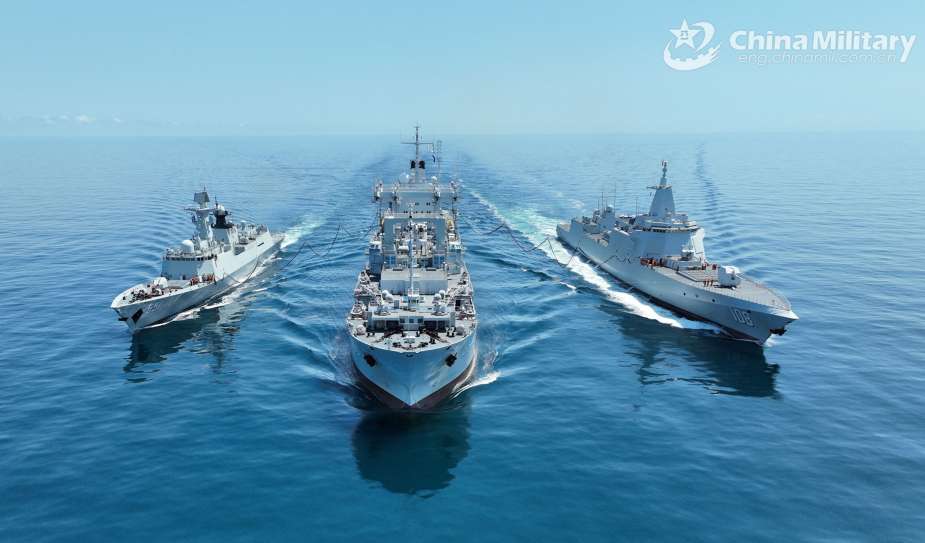Breaking news
US Naval Institute report to Congress alarms on Chinese naval modernization.
The primary focal point of U.S. defense planning and budget allocation revolves around the ongoing modernization of China's military, specifically emphasizing its naval capabilities. This endeavor has been in progress for approximately three decades, commencing in the early to mid-1990s, and has led to a substantial enhancement of China's naval power, rendering it significantly more modern and proficient. Within China's nearby maritime territories, the Chinese navy has emerged as a potent military force, and its operational scope is expanding steadily into the broader expanses of the Western Pacific, the Indian Ocean, and waters in the vicinity of Europe, as detailed in the US Naval Institute report to Congress on Chinese naval modernization.
Follow Navy Recognition on Google News at this link
 Warships attached to a combat support ship flotilla of the navy under the PLA Southern Theater Command steam in formation to conduct alongside replenishment-at-sea on September 22, 2023 (Picture source: eng.chinamil.com.cn/Peng Jun)
Warships attached to a combat support ship flotilla of the navy under the PLA Southern Theater Command steam in formation to conduct alongside replenishment-at-sea on September 22, 2023 (Picture source: eng.chinamil.com.cn/Peng Jun)
China’s navy is, by far, the largest of any country in East Asia, and sometime between 2015 and 2020 it surpassed the U.S. Navy in number of battle force ships. DOD states that China’s navy “is the largest navy in the world with a battle force of over 370 platforms, including major surface combatants, submarines, ocean-going amphibious ships, mine warfare ships, aircraft carriers, and fleet auxiliaries. Notably, this figure does not include approximately 60 HOUBEI-class patrol combatants that carry anti-ship cruise missiles (ASCM). The… overall battle force [of China’s navy] is expected to grow to 395 ships by 2025 and 435 ships by 2030.” The U.S. Navy, by comparison, included 291 battleforce ships as of October 19, 2023, and the Navy’s FY2024 budget submission projects that the Navy will include 290 battleforce ships by the end of FY2030. U.S. military officials and other observers are expressing concern or alarm regarding the pace of China’s naval shipbuilding effort, the capacity of China’s shipbuilding industry compared with the capacity of the U.S. shipbuilding industry, and resulting trend lines regarding the relative sizes and capabilities of China’s navy and the U.S. Navy.
China’s naval modernization effort encompasses a wide array of ship, aircraft, weapon, and C4ISR (command and control, communications, computers, intelligence, surveillance, and reconnaissance) acquisition programs, as well as improvements in logistics, doctrine, personnel quality, education and training, and exercises. China’s navy currently has certain limitations and weaknesses, which it is working to overcome.
China’s military modernization effort, including its naval modernization effort, is assessed as being aimed at developing capabilities for, among other things, addressing the situation with Taiwan militarily, if need be; achieving a greater degree of control or domination over China’s near-seas region, particularly the South China Sea; defending China’s commercial sea lines of communication (SLOCs), particularly those linking China to the Persian Gulf; displacing U.S. influence in the Western Pacific; and asserting China’s status as the leading regional power and major world power. Observers believe China wants its navy to be capable of acting as part of an anti-access/area-denial (A2/AD) force—a force that can deter U.S. intervention in a conflict in China’s near-seas region over Taiwan or some other issue or failing that, delay the arrival or reduce the effectiveness of intervening U.S. forces.
The U.S. Navy has taken a number of actions to counter China’s naval modernization effort. Among other things, the U.S. Navy has shifted a greater percentage of its fleet to the Pacific; assigned its most-capable new ships and aircraft to the Pacific; maintained or increased general presence operations, training and developmental exercises, and engagement and cooperation with allied and other navies in the Indo-Pacific; increased the planned future size of the Navy; initiated, increased, or accelerated numerous programs for developing new military technologies and acquiring new ships, aircraft, unmanned vehicles, and weapons; developed new operational concepts for countering Chinese maritime A2/AD forces; and signaled that the Navy in coming years will shift to a more-distributed fleet architecture that will feature substantially greater use of unmanned vehicles. The issue for Congress is whether to approve, reject, or modify the Biden Administration’s proposed U.S. Navy plans, budgets, and programs for responding to China’s naval modernization effort.




























